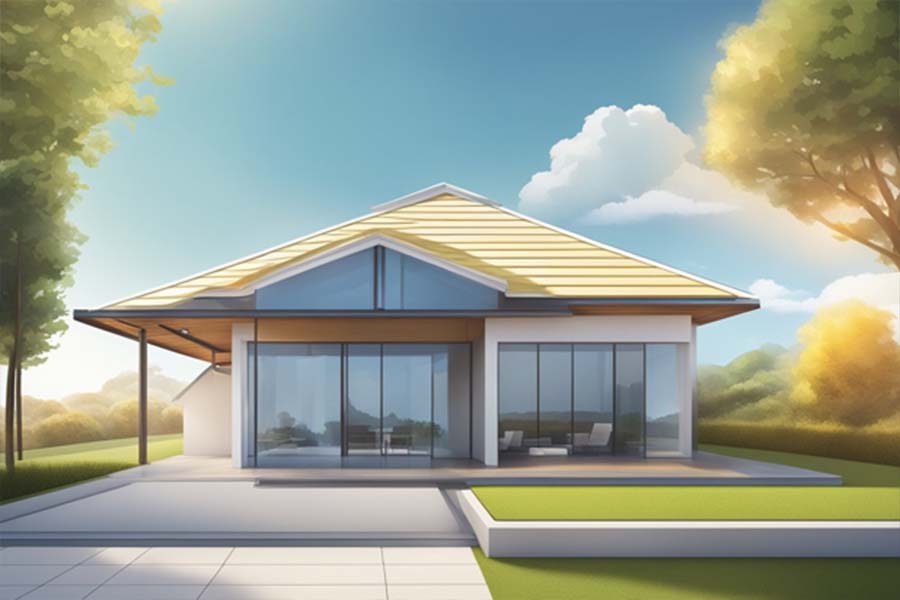Roof coatings have become increasingly popular in recent years due to their ability to extend the lifespan of a roof and improve energy efficiency. A roof coating is a layer of material that is applied to the surface of a roof to protect it from the elements and prevent damage from occurring. There are many different types of roof coatings available, each with its own unique benefits and advantages.
One of the main benefits of roof coatings is their ability to extend the lifespan of a roof. A properly applied roof coating can help to protect the underlying roofing material from the damaging effects of UV rays, moisture, and other environmental factors. This can help to prevent leaks, cracks, and other types of damage that can lead to costly repairs or even a full roof replacement. Additionally, roof coatings can help to reduce the amount of maintenance required to keep a roof in good condition, which can save time and money in the long run.
Understanding Roof Coatings
Types of Roof Coatings
Roof coatings are designed to protect and extend the life of a roof. There are different types of roof coatings available, each with their own unique properties and benefits. Some of the most common types of roof coatings include:
- Acrylic roof coatings: These coatings are water-based and offer excellent reflectivity, which helps to reduce energy costs. They are also easy to apply and maintain.
- Silicone roof coatings: These coatings are highly durable and offer excellent resistance to weathering, UV radiation, and water. They are also highly reflective, which helps to keep the building cool.
- Polyurethane roof coatings: These coatings are highly durable and offer excellent resistance to impact, abrasion, and chemicals. They are also highly reflective and can help to reduce energy costs.
- Asphalt roof coatings: These coatings are made from asphalt and are designed to protect and extend the life of asphalt roofs. They are highly durable and offer excellent resistance to weathering and UV radiation.
How Roof Coatings Work
Roof coatings work by forming a protective barrier on the surface of the roof. This barrier helps to protect the roof from the elements, including UV radiation, water, and chemicals. Roof coatings can also help to reflect sunlight, which helps to keep the building cool and reduce energy costs.
Roof coatings are typically applied in thin layers using a spray, brush, or roller. The number of layers required will depend on the type of coating and the condition of the roof. It is important to ensure that the roof is clean and free from debris before applying the coating.
In summary, roof coatings are an effective way to protect and extend the life of a roof. With different types of coatings available, it is important to choose the right one for your specific needs. By understanding how roof coatings work, you can make an informed decision and ensure that your roof is protected for years to come.
Enhancing Longevity
Protection Against Elements
Roof coatings are essential in protecting roofs from harsh elements such as UV rays, rain, snow, and wind. The coatings act as a barrier that prevents these elements from penetrating the roof, which can cause damage over time. With a high-quality roof coating, the roof is shielded from the elements, which significantly increases its lifespan.
Preventing Leaks and Damage
Roof coatings are also effective in preventing leaks and other types of damage. When a roof is coated, it becomes more resistant to water, which means that water is less likely to seep through the roof and cause damage to the structure. Additionally, a roof coating can help prevent cracks and other forms of damage that can occur due to exposure to the elements. By preventing leaks and damage, a roof coating can help ensure that a roof lasts for many years.
Maintenance and Repair Reduction
Roof coatings can also help reduce the need for maintenance and repairs. When a roof is coated, it becomes more durable and resistant to damage. This means that the roof requires less maintenance over time, which can save time and money. Additionally, a roof coating can help prevent damage to the roof, which means that repairs are less likely to be needed. By reducing maintenance and repair needs, a roof coating can help ensure that a roof remains in good condition for many years.
Overall, roof coatings are an effective way to enhance the longevity of a roof. By protecting against the elements, preventing leaks and damage, and reducing maintenance and repair needs, a roof coating can help ensure that a roof lasts for many years.
Improving Energy Efficiency
Reflectivity and Thermal Emittance
Roof coatings can significantly improve a building’s energy efficiency by reducing heat absorption and transfer. Reflective coatings can reflect up to 90% of sunlight, reducing the amount of heat that enters the building. Thermal emittance, on the other hand, allows the roof to release absorbed heat back into the atmosphere, further reducing heat transfer to the building. These combined benefits can help reduce the amount of energy needed to cool the building, resulting in lower cooling costs.
Reducing Cooling Costs
By reducing the amount of heat absorbed by the roof, roof coatings can help reduce cooling costs. This is particularly important in hot climates where air conditioning can account for a significant portion of a building’s energy consumption. Reflective coatings can help reduce the amount of heat that enters the building, while thermal emittance can help release absorbed heat back into the atmosphere. This can result in lower cooling costs and a more comfortable indoor environment.
Contribution to Sustainable Building Practices
Roof coatings can contribute to sustainable building practices by reducing a building’s energy consumption and carbon footprint. By reducing the amount of energy needed to cool the building, roof coatings can help reduce greenhouse gas emissions associated with energy production. Additionally, some roof coatings are made from sustainable materials and can be recycled at the end of their useful life, further reducing their environmental impact.
Overall, roof coatings can provide significant benefits for improving a building’s energy efficiency. By reducing heat absorption and transfer, roof coatings can help reduce cooling costs and contribute to sustainable building practices.
Cost-Benefit Analysis
Initial Investment vs. Long-Term Savings
When considering the cost of roof coatings, it is important to take into account the initial investment as well as the long-term savings. While the initial cost of applying a roof coating may be higher than simply replacing a roof, the long-term benefits can often outweigh the initial investment.
Roof coatings can extend the life of a roof by up to 25 years and reduce energy costs by up to 30%. This means that over time, the cost of a roof coating can be significantly lower than the cost of replacing a roof and paying higher energy bills.
Life Cycle Cost of Roof Coatings
When comparing the cost of roof coatings to the cost of roof replacement, it is important to consider the life cycle cost of each option. The life cycle cost takes into account the initial cost as well as the cost of maintenance, repairs, and replacement over the life of the roof.
Roof coatings have a lower life cycle cost than roof replacement. This is because a roof coating can extend the life of a roof and reduce the need for costly repairs and replacements. Additionally, roof coatings require less maintenance than traditional roofing materials, further reducing the overall cost.
Overall, while the initial cost of roof coatings may be higher than traditional roofing materials, the long-term savings and lower life cycle cost make them a cost-effective option for many building owners.
Application and Installation
Proper Application Techniques
When it comes to applying roof coatings, it is essential to follow the manufacturer’s instructions carefully. The first step is to clean the roof surface thoroughly to remove any dirt, debris, or other contaminants. This can be done using a pressure washer or a high-pressure hose. After cleaning, the surface must be allowed to dry completely before applying the coating.
Once the surface is clean and dry, the coating can be applied using a brush, roller, or sprayer. It is important to apply the coating evenly and at the recommended thickness. This will ensure that the coating provides the maximum protection and longevity.
Choosing the Right Contractor
Choosing the right contractor for the job is critical to ensure that the roof coating is applied correctly and provides the desired benefits. It is important to choose a contractor who has experience with roof coatings and can provide references from satisfied customers.
Additionally, it is important to ensure that the contractor is properly licensed and insured. This will protect both the contractor and the homeowner in case of any accidents or damage during the installation process.
When choosing a contractor, it is also important to get a written estimate that includes all of the costs associated with the installation. This will help ensure that there are no surprises or hidden costs later on.
By following these proper application techniques and choosing the right contractor, homeowners can ensure that their roof coatings are installed correctly and provide the maximum benefits for longevity and efficiency.
Case Studies and Real-World Examples
Roof coatings have been used for decades to help extend the life of commercial and industrial roofs, as well as improve their energy efficiency. Here are a few real-world examples of how roof coatings have benefited various businesses:
Example 1: Retail Store
A retail store in a hot and sunny climate was experiencing high energy costs due to the constant need for air conditioning. The roof was also showing signs of wear and tear, which could lead to costly repairs. The store owner decided to apply a reflective roof coating to the roof. The coating helped to reflect sunlight and reduce the amount of heat absorbed by the roof, which in turn reduced the need for air conditioning. The store owner was able to save money on energy costs and avoid costly repairs.
Example 2: Manufacturing Plant
A manufacturing plant with a large flat roof was experiencing leaks and water damage. The roof was also absorbing heat, which was making the plant uncomfortably hot for workers. The plant manager decided to apply a waterproof roof coating to the roof. The coating helped to seal any leaks and prevent further water damage. The reflective properties of the coating also helped to reduce the amount of heat absorbed by the roof, making the plant more comfortable for workers.
Example 3: Office Building
An office building with an older roof was experiencing leaks and high energy costs. The building owner decided to apply a roof coating to the roof. The coating helped to seal any leaks and prevent further water damage. The reflective properties of the coating also helped to reduce the amount of heat absorbed by the roof, which reduced the need for air conditioning. The building owner was able to save money on energy costs and avoid costly repairs.
These examples demonstrate the benefits of roof coatings for both longevity and efficiency. By applying a roof coating, businesses can extend the life of their roofs, reduce energy costs, and avoid costly repairs.





0 Comments